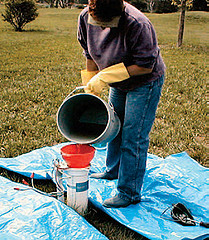
UNIVERSITY PARK – The central and eastern parts of the state were saturated by frequent heavy rains in early August before being drenched by Hurricane Irene and then inundated by the remnants of Tropical Storm Lee. The resulting flooding could have contaminated many private water wells.
Well owners should disinfect the water supplies before drinking water from them, according to a water-quality expert in Penn State’s College of Agricultural Sciences.
“Hundreds if not thousands of water wells were flooded by the runoff from this latest storm,” said Bryan Swistock, water resources extension specialist. “In addition to seeing flood water around their wells or springs, homeowners also might notice increased sediment in their water. Even after this goes away, bacteria still may contaminate the water supply.”
Swistock noted that a simple coliform bacteria test from a water-testing lab can determine if the water supply is safe to use or if disinfection is needed. “If residents suspect that their wells may be contaminated, they should contact their local or state health department or county Penn State Extension office for specific advice on disinfecting them,” he said.
Swistock urged residents to follow the suggestions below — found on the U.S. Environmental Protection Agency Web site for dealing with a well that likely was flooded. Local water-well drillers and contractors should be contacted to inspect well components.
— Well and pump inspection: If flood conditions are known to have occurred or are suspected at a well, the well and pump should be inspected. Swiftly moving flood water can carry large debris that could loosen well hardware, dislodge well construction materials or distort the casing. Coarse sediment in the flood waters could erode pump components. If the well is not tightly capped, sediment and flood water could enter the well and contaminate it. Floods also may cause some wells to collapse.
— Check the electrical system. After flood waters have receded and the pump and electrical system have dried, do not turn on the equipment until the wiring system has been checked by a qualified electrician, well contractor or pump contractor. If the pump’s control box was submerged during the flood, all electrical components must be dry before electrical service can be restored. Get assistance in turning the pump on from a well or pump contractor.
— Monitor pump operation. All pumps and their electrical components can be damaged by sediment and flood water. The pump, including the valves and gears, will need to be cleaned of silt and sand. If pumps are not cleaned and lubricated properly, they can burn out. Get assistance from a well or pump contractor, who will be able to clean, repair and maintain different types of pumps.
— Emergency disinfection of wells that have been flooded. Before disinfection, check the condition of the well. Make sure there is no exposed or damaged wiring. If you notice any damage, call a professional before the disinfection process. Materials needed include at least a gallon of nonscented household liquid bleach, rubber gloves, eye protection, old clothes and a funnel.
To disinfect, follow these steps:
— If the water is muddy or cloudy, run the water from an outside spigot with a hose attached until the water becomes clear and free of sediment.
— Determine what type of well you have and how to pour the bleach into the well. Some wells have a sanitary seal with either an air vent or a plug that can be removed. If it is a bored or dug well, the entire cover can be lifted off to provide a space for pouring the bleach into the well.
– -Mix a gallon of bleach with a few gallons of water. Take the chlorine mixture funnel (if needed) and carefully pour the bleach mixture down into the well casing.
— After the bleach has been added, run water from an outside hose into the well casing until you smell chlorine coming from the hose, then turn off the outside hose. If chlorine odor never develops at the faucet, you may need to add more bleach to the well.
— Turn on all cold water faucets, inside and outside of the house, until the chlorine odor is detected in each faucet, then shut them all off. If you have a water treatment system, switch it to bypass before turning on the indoor faucets.
— Wait six to 24 hours before turning the faucets back on. It is important not to use this water for drinking, cooking, bathing or washing during that time period — it contains high amounts of chlorine.
— Once the waiting period is up, turn on an outside spigot with hose attached and run the water into a safe area where it will not disturb plants, lakes, streams or septic tanks. Run the water until there is no longer a chlorine odor. Turn the water off.
The system now should be disinfected, and you can use the water. However, the water should not be used for drinking until a bacteria test indicates that the disinfection procedure was effective. Have the water tested for bacteria seven to 10 days after disinfection.
For more information, visit the EPA’s website on flooded well safety, or download the free Penn State fact sheet, “Shock Chlorination of Wells and Springs.”
Jeff Mulhollem, Penn State University


